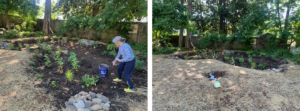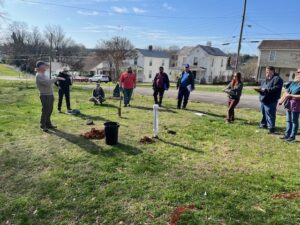Stormwater is a technical field, with its alphabet soup and rich collection of jargon: BMPs, SCMs, TMDLs, MS4, and the list goes on. But, if the messaging is right, everyone can comprehend runoff and water pollution, but not always what role an individual or business can play to address it. That’s where Stormwater For The People comes in!
I am referring here to the many programs that provide cost-share and technical assistance to individual property owners, businesses, and local governments to implement stormwater practices (BMPs) on their properties. Many of the practices are small-scale, such as rain gardens, conservation landscaping, and rainwater harvesting. As such, the pollutant reduction numbers for each project – the juggernaut currency of the Chesapeake Bay and other TMDLs – are low. But, as the saying goes, “Not everything that can be counted counts, and not everything that counts can be counted.” This quote is often attributed to Albert Einstein, but it is probably from 1960s sociologist William Bruce Cameron.

“Not everything that can be counted counts, and not everything that counts can be counted.” The quote is often attributed to Einstein (likey erroneously), but he certainly knew a few things about counting. (Graphic: Chen from Pixabay)
It is the second part of the quote (to paraphrase — some really awesome stuff can’t be put into numerical terms) that I believe applies to the many efforts of watershed groups and local governments to engage individuals in neighborhoods and business districts across the Bay region. The part that is hard to count is the value of that engagement, the sweat equity that property owners and managers put into BMP installation and maintenance, the dirt under their fingernails, and the bragging rights that they spread to neighbors, friends, and colleagues. And yes, in a cumulative sense, the pollutant reductions can also go into the model or contribute to MS4 compliance.
There are too many such programs for me to list, and I would surely leave some out. In general, the programs are promoted with names such as River Heroes, River Smart Homes, River Star, River Friendly Home/Businesses, etc.
There are also state-wide programs that promote and provide cost-share for homeowner practices, including converting lawns to more environmentally-friendly practices. One such program that I am familiar with is the Virginia Conservation Assistance Program (VCAP). VCAP is operated by the Virginia Association of Conservation Districts (VASWCD), with individual soil and water conservation district staff in the property owner liaison role.
Over the years, the program has developed the necessary materials to provide the structure for this kind of a state-wide effort. These resources include a program BMP manual, project ranking spreadsheet (yes, pollutant removal is a part of that), spot-check forms for completed practices, and many learning resources for district staff and interested property owners. Association staffers Blair and Rachel provide overall program coordination with a good measure of TLC.
I have had the honor to work on several VCAP projects over the years and worked recently through the Chesapeake Bay Landscape Professional program to provide tailored training for SWCD staff. The photo montage below summarizes the steps involved in one recent project – a rain garden on residential property – in case that is illustrative for others out there who are involved in such projects. The photos are divided into the different phases of the project: Planning, Digging, Laying, and Planting.

Planning: Left: This project started with a property master plan that included the rain garden as well as conservation landscaping and other projects the homeowner was interested in. Right: The VCAP application process requires an infiltration test to determine the need for an underdrain (or not). We were quite fortunate here to have suitable infiltration rates, so no underdrain was used. This is NOT often the case in your part of Virginia.

Digging: Left: The mini-excavator came in handy to dig the hole. Right: It was important to check that finished excavation was level.

Layering: Left & Middle: We mixed the existing soil with sand and then added a thin layer of mulch and formed up the berm. Right: We used a simple site level to make sure the layers and berm were at correct elevations.

Planting: The property owner loved this part. She is enthusiastic about native plants and enjoyed both the shopping and planting parts. Now comes the maintenance!

At the VCAP training in Lynchburg for soil & water conservation district staff from around the state, engineer, Chris Sonne, demonstrates several ways to conduct an infiltration test and soil investigation. The training was hosted by VCAP and the Chesapeake Bay Landscape Professional (CBLP) program.
Many thanks to Dawn, the very enthusiastic property owner, Melissa from Osceola Land Design, Meghan from the Thomas Jefferson Soil & Water Conservation District, VASWCD staff Blair and Rachel, Gerry from Corridon Builders, and native plant nurseries Hill House and Sandy’s Plants. It takes a village, even for a small rain garden!
David J. Hirschman, dave@hirschmanwater.com
June 27, 2024
